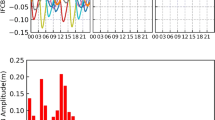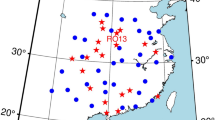Abstract
To meet the demands of precise orbit and clock determination, high-precision positioning, and navigation applications, a software called GREAT (GNSS + Research, Application and Teaching) was designed and developed at Wuhan University. As one important module in the GREAT software, GREAT-UPD was developed for multi-GNSS and multi-frequency uncalibrated phase delay (UPD) estimation. It can provide extra-wide-lane (EWL), wide-lane (WL), and narrow-lane (NL) UPDs for GPS, GLONASS, Galileo and BDS (GREC) satellites for precise point positioning (PPP) ambiguity resolution (AR) in a multi-GNSS and multi-frequency environment. The open-source GREAT-UPD software is written in C + + 11 language following object-oriented principles and can be compiled and run on several popular operating systems, such as Windows, Linux, and Macintosh. Observations from 222 stations spanning days from DOY 091 to 120 were used to conduct multi-GNSS and multi-frequency UPD estimation and PPP AR. Results indicate that GREAT-UPD can generate stable and reliable UPD products with multi-GNSS and multi-frequency observations. After applying the UPD corrections, the multi-frequency GREC PPP AR was achieved with the averaged time to first fix of 9.0 min. The software package can be obtained at https://geodesy.noaa.gov/gps-toolbox, including the source code, user manual, batch processing scripts, example data, and some auxiliary tools.







Similar content being viewed by others
References
Banville S, Geng J, Loyer S, Schaer S, Springer T, Strasser S (2020) On the interoperability of IGS products for precise point positioning with ambiguity resolution. J Geod 94(1):10
Blewitt G (1990) An automatic editing algorithm for GPS data. Geophys Res Lett 17(3):199–202
Collins P, Lahaye F, Herous P, Bisnath S (2008) Precise point positioning with ambiguity resolution using the decoupled clock model. In: Proceedings of ION GNSS 2008, Institute of Navigation, Savannah, Georgia, US, 16–19, 1315–1322
Ge M, Gendt G, Rothacher M, Shi C, Liu J (2008) Resolution of GPS carrier phase ambiguities in precise point positioning (PPP) with daily observations. J Geod 82(7):389–399
Geng J, Bock Y (2016) GLONASS fractional-cycle bias estimation across inhomogeneous receivers for PPP ambiguity resolution. J Geod 90(4):379–396
Gu S, Lou Y, Shi C, Liu J (2015) Beidou phase bias estimation and its application in precise point positioning with triple-frequency observable. J Geod 89(10):979–992
Hatch R (1982) The synergism of GPS code and carrier measurements. In: Proceedings of the third international symposium on satellite Doppler positioning at physical sciences laboratory of New Mexico State University. 2 (8): 1213–1231
Hu J, Zhang X, Li P, Ma F, Pan L (2020) Multi-GNSS fractional cycle bias products generation for GNSS ambiguity-fixed PPP at Wuhan University. GPS Solut 24(1):15
Kouba J, Héroux P (2001) Precise point positioning using IGS orbit and clock products. GPS Solut 5(2):12–28
Laurichesse D, Mercier F, Berthias JP, Broca P, Cerri L (2009) Integer ambiguity resolution on undifferenced GPS phase measurements and its application to PPP and satellite precise orbit determination. Navig J Inst Navig 56(2):135–149
Li P, Zhang X, Guo F (2017) Ambiguity resolved precise point positioning with GPS and BeiDou. J Geod 91(1):25–40
Loyer S, Perosanz F, Mercier F, Capdeville H, Marty J (2012) Zero difference GPS ambiguity resolution at CNES-CLS IGS analysis center. J Geod 86(11):991–1003
Li X, Liu G, Li X, Zhou F, Feng G, Yuan Y, Zhang K (2020a) Galileo PPP rapid ambiguity resolution with five-frequency observations. GPS Solut 24(1):24
Li X, Liu G, Feng G, Yuan Y, Zhang K, Ren X (2019) Triple-frequency PPP ambiguity resolution with multi-constellation GNSS: BDS and Galileo. J Geod 93(8):1105–1122
Li X, Liu G, Xie W, Feng G (2020b) The phase and code biases of Galileo and BDS-3 BOC signals: effect on ambiguity resolution and precise positioning. J Geod. https://doi.org/10.1007/s00190-019-01336-9
Li X, Li X, Yuan Y, Zhang K, Zhang X, Wickert J (2018) Multi-GNSS phase delay estimation and PPP ambiguity resolution: GPS, BDS, GLONASS. Galileo J Geod 92(6):579–608
Li X, Zhang X (2012) Improving the estimation of uncalibrated fractional phase offsets for PPP ambiguity resolution. Navig 65(3):513–529
Liu Y, Song W, Lou Y, Ye S, Zhang R (2017) GLONASS phase bias estimation and its PPP ambiguity resolution using homogeneous receivers. GPS Solut 21(2):427–437
Malys S, Jensen PA (1990) Geodetic Point Positioning with GPS Carrier Beat Phase Data from the CASA UNO Experiment. Geophys Res Lett 17(5):651–654
Montenbruck O, Steigenberger P, Prange L, Deng Z, Zhao Q, Perosanz F, Schmid R (2017) The multi-GNSS experiment (MGEX) of the international GNSS service (IGS)—achievements, prospects and challenges. Adv Space Res 59(7):1671–1697
Melbourne WG (1985) The case for ranging in GPS-based geodetic systems. In: Proceedings of the first international symposium on precise positioning with the global positioning system, Rockville, US, pp 373–386
Vaclavovic P, Dousa J, Gyori G (2013) G-nut software library-state of development and first results. Acta Geodyn Geomater 10(4):431–436
Wübbena G (1985) Software developments for geodetic positioning with GPS using TI-4100 code and carrier measurements. In: Proceedings of the first international symposium on precise positioning with the global positioning system, Rockville, US, pp 403–412
Yao Z, Zhang J, Lu M (2016) ACE-BOC: dual-frequency constant envelope multiplexing for satellite navigation. IEEE Trans Aerosp Electron Syst 52(1):466–485
Zumberge JF, Heflin MB, Jefferson DC, Watkins MM, Webb FH (1997) Precise point positioning for the efficient and robust analysis of GPS data from large networks. J Geophys Res 102(B3):5005–5017
Acknowledgements
This work has been supported by the National Natural Science Foundation of China (Grant 41774030, Grant 41974027 and Grant 41974029), the Hubei Province Natural Science Foundation of China (Grant 2018CFA081), the frontier project of basic application from Wuhan science and technology bureau (Grant 2019010701011395), and the Sino-German mobility program (Grant No. M0054). The numerical calculations in this paper have been done on the supercomputing system in the Supercomputing Center of Wuhan University.
Author information
Authors and Affiliations
Corresponding author
Additional information
Publisher's Note
Springer Nature remains neutral with regard to jurisdictional claims in published maps and institutional affiliations.
The GPS Tool Box is a column dedicated to highlighting algorithms and source code utilized by GPS engineers and scientists. If you have an interesting program or software package you would like to share with our readers, please pass it along; e-mail it to us at gpstoolbox@ngs.noaa.gov. To comment on any of the source code discussed here, or to download source code, visit our website athttp://www.ngs.noaa.gov/gps-toolbox . This column is edited by Stephen Hilla, National Geodetic Survey, NOAA, Silver Spring, Maryland, and Mike Craymer, Geodetic Survey Division, Natural Resources Canada, Ottawa, Ontario, Canada.
Rights and permissions
About this article
Cite this article
Li, X., Han, X., Li, X. et al. GREAT-UPD: An open-source software for uncalibrated phase delay estimation based on multi-GNSS and multi-frequency observations. GPS Solut 25, 66 (2021). https://doi.org/10.1007/s10291-020-01070-2
Received:
Accepted:
Published:
DOI: https://doi.org/10.1007/s10291-020-01070-2




